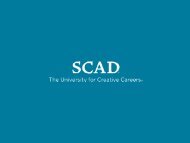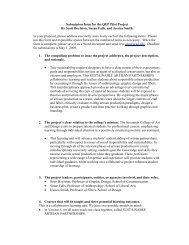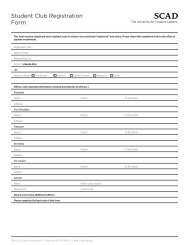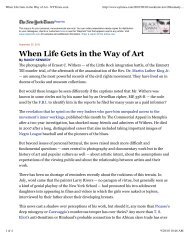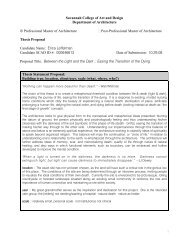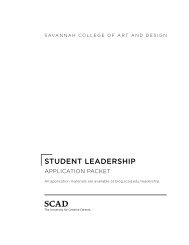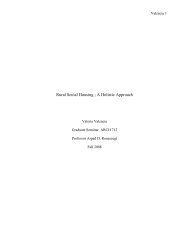Nicole Roberts MFA Thesis Visual Component Artwork - Savannah ...
Nicole Roberts MFA Thesis Visual Component Artwork - Savannah ...
Nicole Roberts MFA Thesis Visual Component Artwork - Savannah ...
Create successful ePaper yourself
Turn your PDF publications into a flip-book with our unique Google optimized e-Paper software.
Frequent debates occur over which curricular<br />
components are ‘sacred cows,’ but the solution is<br />
tangibly resolved only in a handful of programs like<br />
Rhode Island School of Design (risd) and University<br />
of Cincinnati’s College of Design, Architecture,<br />
Art, and Planning (daap). risd’s Bachelor of Fine<br />
Arts (bfa) degree is a typical four-year program<br />
offering the expected course requirements, such as<br />
foundations, liberal arts, electives, and various design<br />
studios. Above and beyond the bfa curriculum, risd<br />
also offers an optional fifth year of coursework,<br />
which results in a Bachelor of Graphic Design (bgd)<br />
degree. This additional year enables students to<br />
acquire 6 credit hours of professional internships<br />
(as opposed to zero required for the bfa). It also<br />
incorporates 12 more graphic design studio credit<br />
hours, 9 additional art and design elective credit<br />
hours, and 3 more liberal arts credit hours. risd’s<br />
solution is a win-win for both educators and students.<br />
RISD 2009–2010 Undergraduate<br />
Graphic Design Curriculum comparing<br />
BFA & BGD credit hour distribution<br />
The need for additional time beyond the fourth<br />
year is addressed, along with the preservation of<br />
established coursework to compensate for the lack of<br />
time. By giving students this option, it allows them to<br />
gauge their competency level versus their career goals<br />
during their senior year of the design program and<br />
decide if the additional year is warranted.<br />
In contrast, daap in Cincinnati, Ohio also offers<br />
a five-year program, yet it is treated as a standard<br />
requirement to obtain a Bachelor of Science in<br />
Graphic Design, not a supplemental add-on. As a<br />
result, graphic design majors graduate from daap<br />
with a year and a half of professional practice<br />
experience, and are therefore better prepared to enter<br />
into the full-time workplace over other students with<br />
little to no experience.<br />
Another curricular concept that is rarely<br />
visualized within design school publications is their<br />
evaluation process of student work. Due to the<br />
increase in complexity of today’s design programs,<br />
portfolio reviews for admissions is more necessary<br />
than ever. 70% of professors polled are against open<br />
admission policies and believe that portfolios should<br />
be required for acceptance into reputable graphic<br />
design programs. This process favorably catches<br />
students who may need preliminary instruction<br />
prior to delving into the rigorous graphic design<br />
studio courses, yet it also creates an adverse aura<br />
of exclusivity surrounding the program itself.<br />
54




